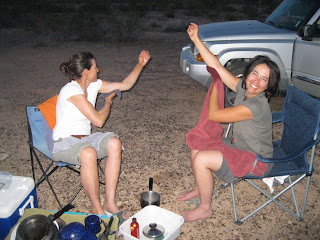
Sunrise in the low, flat valleys. Tapes pulled taut across our transects. The comfort of the morning before it really heats up. The sharp, clear light casting on western hills, defining and projecting the sharp ridges and ripples of the old mountains. Cool winds, the relict of the night, in their last fleeting tickles across our skin, gracefully halt as the sun creeps above the mountains and the day really begins.
This job has been a crisp lesson on the contrast of image and reality in the desert. It's not all vast, pristine scenes. It's not all drama, granduer, and wilderness. Because our hand has swept across this land, it's far less than that.
This past week, we camped near feedlots teeming with ruined water and beaten soil; under powerlines whose robot-like towers gave buzzards room to roost; beside a 'lake' nestled in a middle-of-nowhere wasteland where ATV's probably outnumber coyotes; withi sight of a massive microwave relay station; we've driven down arrow straight natural gas pipelines; we've marched across range where the only thing the cattle seem to eat is bufflegrass; we logged almost 900 miles of driving; and we almost always were lulled to sleep by the distant roar of commerce on the highways and rails. Commercial flights; private prop-planes; constant military air traffic; flyovers less than 500 feet above us; missles hanging phallically, poised for release to inseminate the world with more war. Endless noise. Never silence. Deep rumbles, high-pitch whines; all degrees of motor, wheel, road, and steel. Everyone is racing towards nothing. What is this?
Here, in the place called Sonoran, where the motorhomes outnumber actual houses; where ATV's outnumber any other form of recreation; we travel on roads built exclusively in the name of the desecration of the earth. Old miners roads, pipelines, gravel hauling routes, along railways, between point A and point B that only came into being because of some vein in the mountain bled so that we might get a little richer.
When the morning comes, and the sky begins to glow, and the birds begin their singing, and we stir in our clammy sacks woven from the blood of the Earths ancient mudswamps; we might find that singular moment of unity between air, sky, soil, earth, our brother and sister creatures, and our selves. We can, if we remember to, before we start racing around like everyone else, point A to point B, eyes stuck to the little poor helpless plants that we mercilessly and voraciously tug and snip and rip from the soil. "Thank you, I'm sorry; thank you, I'm sorry; thank you, I'm sorry...."thousands of times, over and over, until I forget what I'm sorry for, and the bags pile up, and we drive somewhere else. The mountain sits there, unchanged, immovable, silent, wondering when someone will STOP...and listen, for a moment, and find within the humming, droning, rumbling, tired old sounds of deisel and gas coughing us along our dimly lit paths, and there, between the wheezing breaths of societies freneticism; a moth on the chicory flower, or a sad dove heralding the new day, or the clickity-clickity-clicking of thousands of stiff spiney wolfberry branches dancing in the wild summit wind of an ancient volcano.
Inhale; exhale; joining our breath with the Earths; accepting that what we exhale from this stuff of ours, we promptly inhale deeply into our lungs to be part of us. We are now what we have just been. And then we drive some more, desert passing by, the plants just there, waiting to be draped by another tape, another day.




 Thanks, Steve and Jill, for a rockin' good time! And next time you see Jill, be sure to ask her about her close encounter at Quartzsite's Reader's Oasis bookstore.
Thanks, Steve and Jill, for a rockin' good time! And next time you see Jill, be sure to ask her about her close encounter at Quartzsite's Reader's Oasis bookstore.













